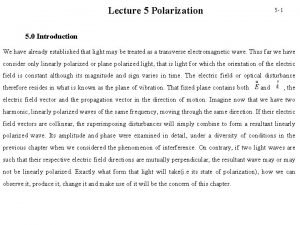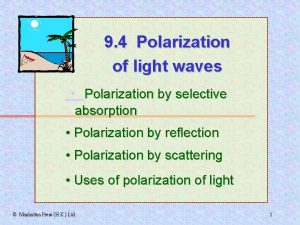Light Waves and Polarization The Nature of Light










- Slides: 10

Light Waves and Polarization

The Nature of Light • Quantum Theory – Light consists of small particles (photons). This theory better explains light detection and generation processes. • Wave Theory – Light travels as a transverse electromagnetic wave. This theory better explains light propagation. • Ray Theory – Light travels along a straight line and obeys laws of geometrical optics – This theory is useful when the objects are much larger than the wavelength of light (Multi Mode Fiber)

Quantum Theory of Light • Light consists of discrete units called photons. The energy in a photon h= 6. 6256 X 10(-34) J. s is the Planck’s constant and ν is the frequency. • Ex 1: Find the energy of a photon travelling with 200 THz frequency • Ex 2: Show

Wave Theory of Light • Electromagnetic light signal has electric and magnetic fields orthogonal to each other. • The frequency of this EM wave is in the order of THz. Therefore, it is convenient to measure it in terms of wavelength. • where, c - speed of light 3 X 108 m/s in air, - frequency and λ- wavelength • Ex: Find the ν when λ = 1550 nm. • Answer: 193. 5 THz ν

Wavelength Ranges

Plane Waves • Most Light waves are plane waves • A plane wave is a constant-frequency wave whose wave fronts (surfaces of constant phase) are infinite parallel planes. • The electric field vector of a plane wave may be arbitrarily divided into two perpendicular components labeled x and y (with z indicating the direction of travel).

Field distributions in plane E&M waves Electric and magnetic fields are orthogonal to each other and to the direction of propagation Z

Polarization • Polarization of a plane wave is the orientation of the oscillations of the E field; perpendicular to the direction of propagation • For a simple harmonic wave, the electric vector in orthogonal directions may have: – Different amplitude – Different phase • The resulting wave is – Linearly, elliptically or circularly polarized

Linear Polarization

Polarization Mode Dispersion (PMD) Each polarization state has a different velocity PMD
 Light waves are transverse waves true or false
Light waves are transverse waves true or false Light polarization equation
Light polarization equation In a curved optical fiber light
In a curved optical fiber light Compare and contrast p waves and s waves using venn diagram
Compare and contrast p waves and s waves using venn diagram Difference between mechanical and electromagnetic waves
Difference between mechanical and electromagnetic waves Mechanical and electromagnetic waves
Mechanical and electromagnetic waves Similarities of mechanical and electromagnetic waves
Similarities of mechanical and electromagnetic waves Long waves and short waves
Long waves and short waves Difference between matter waves and electromagnetic waves
Difference between matter waves and electromagnetic waves Similarities of mechanical and electromagnetic waves
Similarities of mechanical and electromagnetic waves Surface waves and body waves
Surface waves and body waves



















